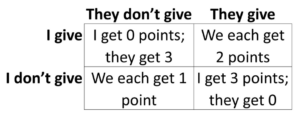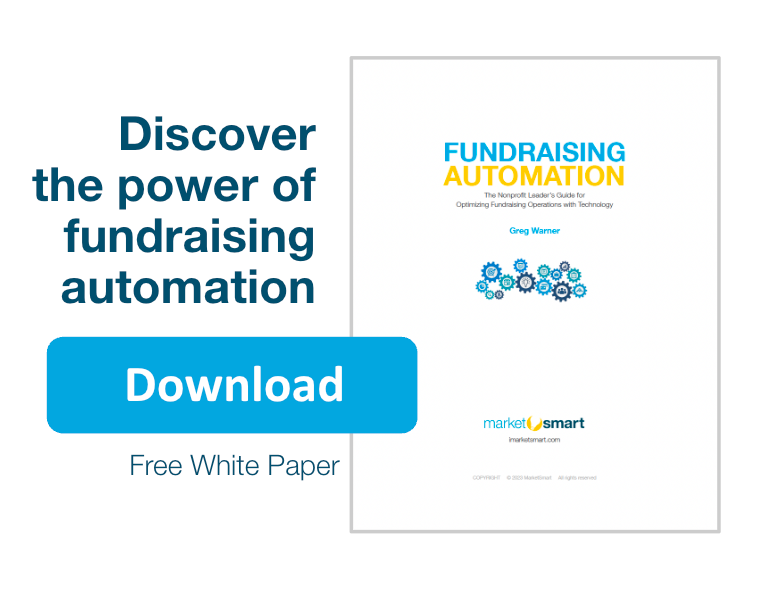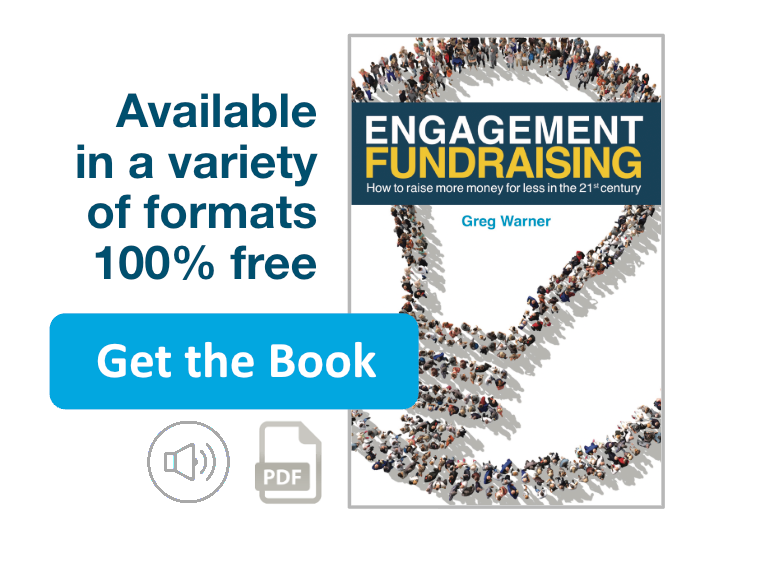Giving vs. sharing
Are we asking people to give? Or are we asking them to share? This might feel like a trivial choice of synonyms. It’s not.
Giving can be “arms-length,” anonymous, and transactional. The giver and receiver are separated. The giver is higher. The receiver is lower. Giving helps “those people.”
Sharing is different. Sharing helps “us.” Each person is both giver and receiver. It’s not equal. But it is reciprocal. It is mutual.
Sharing is communal. It means being part of a group, a partnership, a community. We can ask an outsider to give. But we can’t ask an outsider to share.
Sharing is communal. This means several things:
- Sharing requires membership.
- Sharing is visible to the community.
- Sharing supports community goals.
- Sharing follows community norms.
Examples of giving vs. sharing
Suppose a church member donates for their new building. He’s part of a community, the congregation. By donating, he joins with his fellow donors from this community. They’re working together to fund the new building. He’s also part of the community of beneficiaries. The congregation will use the new building. This gift is sharing.
Next, he gives to his local art museum. He spends time with other donors and art lovers at museum events. (He is part of a community of fellow donors and other supporters.) He enjoys the exhibitions. (He is part of a community of beneficiaries.) This gift is sharing.
Now suppose he donates for another building. He receives a request in the mail. The gift helps those in another country rebuild after an earthquake. This is giving, but it’s not sharing. It isn’t sharing because it isn’t communal. He doesn’t know any other donors. He doesn’t know any beneficiaries. He is an outsider. This gift will likely be much smaller.
Without membership in the supported community, things are different. The donor is an outsider. A donation is no longer sharing. It’s just giving. Remove the community and donations become smaller.
Principles from primal origins
Sharing is different because it is communal. This is also important in natural origins. Sustainable giving to unrelated others can occur in nature. Biologists model this with a game.[1] In the simple game, two players both face these payoffs:

Each must choose before knowing what the other will do. Giving is costly. But if both players give, the overall outcomes are better.
When players interact repeatedly, research shows the winning strategy. Lead with a gift, then act reciprocally.[2] But there’s a problem. This strategy is a winning strategy. But it depends. It depends on the community.
Stable strategies
The game models nature. In nature, a winning strategy must be “evolutionarily stable.”[3] In other words, if everyone follows the strategy, anyone else entering with a different strategy should fail.[4]
Consider how this applies in the game. Suppose everyone always gave no matter what. Everyone wins! This seems great. But it can’t last. It’s not “evolutionarily stable.”
If a “never give” player entered that world, he would win every time. In natural selection, “never give” players would then replicate. They would wipe out the “always give” players. Giving without “tit for tat” reciprocity is not stable.
In the game, an “always give” strategy is not stable. In contrast, reciprocal altruism is stable. You give first. This is altruism. Then, you do whatever that player did to you last time. This is reciprocal altruism. This world can become universally altruistic. Everyone shares with everyone else, except no one shares again with the non-sharers.
This world is stable. Suppose a “never give” player enters. That player wins round one but loses all repeated rounds. Meanwhile, the reciprocal altruism players will be sharing with each other. They will be getting further ahead of the “never give” player. In natural selection, the “never give” player disappears.
Reciprocal altruism is stable. An “always give” strategy is not. Oddly, charities often expect this unnatural “always give” behavior from donors. They keep asking donors to give without any signals of reciprocity. They never even try to deliver value to donors.
In the game, and in nature, reciprocal sharing can be stable and beneficial. Non-reciprocal giving can be deadly. Community can support mutual sharing. But this happens only if the community is reciprocal.
The dark side
Now let’s consider the dark side. Suppose the world is different. Now, it’s composed entirely of “never give” players. What happens to a new reciprocal altruism player? Every time he encounters a new player, he loses. Then he stops giving to that player. But he takes many losses the other players don’t. He finishes last.
This “never give” world is also stable. No new player can win against it.
Return of the altruists
Is this “never give” world permanently stuck? Not necessarily. The “never give” world is stable. No new player can win against it. But a new community of players can.[5]
Again, suppose everyone plays “never give.” Next, a new cluster of reciprocal altruists enters. Whenever possible, they interact with each other. Their mutual sharing pushes them ahead of the “never give” players.
Because they enter as a community, they will dominate the “never give” players. Game theory researchers explain,
“Altruists can survive in such a [‘never share’] world if they are grouped together, so that the benefits of altruism are enjoyed primarily by other Altruists, who then earn relatively high payoffs and are imitated.”[6]
Reciprocal altruists can win, even in a dark “never share” world. They can win, but only if they enter as a community.
The reverse process doesn’t work. (Researchers explain, “The gear wheels of social evolution have a ratchet.”) [7] Once reciprocal altruism becomes dominant, a cluster of “never give” players can’t invade. Even if “never give” players entered as a community, it wouldn’t matter. Their community isn’t helpful. It’s non-cooperative. Community without sharing is useless.
The power of community: Indirect reciprocity
In the game, sustainable giving requires community. A single altruist, even a reciprocal one, is vulnerable. But a community of reciprocal altruists is strong and stable.
A sharing, reciprocal community does something else. It increases the consequences of the giving decision. So far, the game has been focused only on direct interactions between two players. This is called direct reciprocity. Simply put, this means
- You shared with me. Therefore, I share with you.
- You didn’t share with me. Therefore, I don’t share with you.
When giving is visible to a reciprocal community, this changes things. It allows indirect reciprocity.[8] This means,
- You shared with him. Therefore, I share with you.
- You didn’t share with him. Therefore, I don’t share with you.
Before, the reaction to a giving decision was limited. It was limited to one other player. That player might not be encountered again frequently. He might even leave or die.
But an enduring community can last forever. The payback from one player is limited. The potential payback from an entire community is exponentially larger.
Fundraiser as builder of community
The charity can serve as a greenhouse for this community building. Donors can build alliances with the charity and its supporters. Sometimes they can do this with the charity’s beneficiaries, too. As these relationships arise, donors become part of a group. They move from giving to sharing. This is valuable because group members help each other.
The natural tendency to benefit group members arises repeatedly in experiments.[9] It even happens when the other group members are randomly assigned and anonymous. Allowing future cooperation among group members makes the effect even stronger.[10]
It can start simple. Just using “group” language helps. In one experiment, calling a potential donor and recipient “a two-member group” increased donations by 15%.[11] Describing the gift as “dividing” funds among “a two-member group” increased donations by 29%.[12] The language of community and sharing is powerful.
Community support matters
One signal of indirect reciprocity is audience encouragement. In experiments, encouragement from others, such as other donors, increases giving. People are more likely to give when other players make approving statements or indicate that they also plan to give.[13] This encouragement to give was even more powerful when it came from group leaders. This was especially true if the leaders were elected.[14]
One meta-analysis looked at over 100 experiments using variations of the primal-giving game. It found that giving increased whenever conversations between prospective donors were allowed.[15] Even in the lab, building donor community through dialogue increases giving.
Encouragement from others works. But it is only a signal of future indirect reciprocity. If future behavior contradicts the signal, it becomes meaningless. Thus, in experiments, the effect of verbal encouragement fades or disappears when the primal-giving game is repeated. Over time, giving depends upon the actual experience resulting from the gift.[16] In the same way, a charity’s words and phrases can encourage an initial gift. But if the donor’s resulting experience wasn’t worth the gift, he’s unlikely to do it again.
Enhanced identity
“Sharing” delivers more value to the donor than just “giving.” It delivers more indirect reciprocity. It does this through shared membership in a community. But sharing also delivers a higher level of enhanced identity.
Identity comes, at least in part, from group affiliations. It comes from communities. Effective sharing enhances
- The donor’s community
- The donor’s connection with that community, and
- The donor’s standing in that community.
Consider these benefits in terms of the universal hero story. The story’s ending is this: The hero returns to a place of beginning with a gift to improve that world. This is not merely giving. This is sharing. The hero’s original world is a source of his original identity. The concluding gift enhances
- The hero’s original world
- The hero’s re-connection with that original world, and
- The hero’s standing in that original world.
The universal hero story (monomyth) is the story of enhanced identity. It’s a story, ultimately, not just of giving, but of sharing.
Billions
These story elements are powerful. Their power goes beyond just games and experiments. It goes beyond just small gift decisions.
One study analyzed the letters accompanying 187 billionaires’ “giving pledge” commitments.[17] These were pledges to give at least half of their wealth to charity. Most letters included two elements.
First, they included an origin story. The letters referenced family upbringing as the source motivating generosity. The donors’ giving stories started with their original identities. (In the monomyth, this is the original world.)
Second, they referenced a desire not to give, but to “give back.” Giving back is different than giving. It is a circular process. It is a form of sharing. Giving back requires a community. (In the monomyth, the hero returns to the original world with a gift.)
The idea of sharing is powerful. It’s powerful in the lab. It’s powerful in gifts of small amounts. And it’s powerful with gifts of billions.
Next step
Moving from giving to sharing requires community. Building that community can be an important part of fundraising. But community doesn’t spontaneously produce donations.
Fundraising still requires asking. To harness the power of community, that ask must be communal. It must be visible to the community. It must benefit the community or the community’s goals. It must follow the community’s norms. The next article looks at this.
Footnotes:
[1] See, e.g., Boyd, R. (1988). Is the repeated prisoner’s dilemma a good model of reciprocal altruism? Ethology and Sociobiology, 9(2-4), 211-222; Trivers, R. L. (1971). The evolution of reciprocal altruism. The Quarterly Review of Biology, 46(1), 35-57. [2] Axelrod, R., & Hamilton, W. D. (1981). The evolution of cooperation. Science, 211(4489), 1390-1396. p. 1393. [3] The “evolutionarily stable strategy” concept was first presented in Smith, J. M., & Price, G. R. (1973). The logic of animal conflict. Nature, 246(5427), 15-18. They note that it combines game theory and earlier work by W. D. Hamilton. [4] “Roughly, an ESS [Evolutionarily Stable Strategy] is a strategy such that, if most of the members of a population adopt it, there is no “mutant” strategy that would give higher reproductive fitness.” Id. p. 15. [5] Axelrod, R. (1981). The emergence of cooperation among egoists. American Political Science Review, 75(2), 306-318. [6] Eshel, I., Samuelson, L., & Shaked, A. (1998). Altruists, egoists, and hooligans in a local interaction model. American Economic Review, 88(1), 157-179. [7] Axelrod, R., & Hamilton, W. D. (1981). The evolution of cooperation. Science, 211(4489), 1390-1396. p. 1394. [8] Nowak, M. A., & Sigmund, K. (2005). Evolution of indirect reciprocity. Nature, 437(7063), 1291-1298. [9] A review of 212 experimental studies found a consistent increase in donations whenever the donor and recipient were placed in the same group. This worked even when participants were randomly assigned and anonymous. Balliet, D., Wu, J., & De Dreu, C. K. (2014). In-group favoritism in cooperation: a meta-analysis. Psychological Bulletin, 140(6), 1556-1581. [10] See Id. (Allowing actual cooperation, e.g., future sharing, in experiment made group-member favoritism even stronger); Ben-Ner, A., & Kramer, A. (2011). Personality and altruism in the dictator game: Relationship to giving to kin, collaborators, competitors, and neutrals. Personality and Individual Differences, 51(3), 216-221. (This experiment measured willingness to donate to 74 types of recipients. The researchers classified some recipients as potential collaborators, potential competitors, or neutrals. Giving to neutrals was 50% greater than giving to potential competitors. Giving to potential collaborators was 37% higher than giving to neutrals.) [11] Banerjee, P., & Chakravarty, S. (2014). Psychological ownership, group affiliation and other-regarding behaviour: Some evidence from dictator games. Global Economics and Management Review, 19(1-2), 3-15. (Giving changed from 137.3 Rupees to 157.6 Rupees.) [12] Id. (Giving changed from 137.3 Rupees to 177.0 Rupees.) [13] Caldwell, M. (1976). Communication and sex effects in a five‐person prisoner’s dilemma game. Journal of Personality and Social Psychology, 33, 273-280; Caporael, L. R., Dawes, R. M., Orbell, J. M., & Van De Kragt, A. J. C. (1989). Selfishness examined: Cooperation in the absence of egoistic incentives. Behavioral and Brain Sciences, 12, 683-739; Chen, X. P. (1996). The group‐based binding pledge as a solution to public goods problems. Organizational Behavior and Human Decision Processes, 66, 192-202; Dawes, R. M., Mactavish, J., & Shaklee, H. (1977). Behavior, communication, and assumptions about other people’s behavior in a commons dilemma situation. Journal of Personality and Social Psychology, 35, 1-11; Issac, R. M., & Walker, J. (1988). Communication and free riding behavior: The voluntary contribution mechanism. Economic Inquiry, 26, 585-608; Ledyard, J. O. (1995). Public goods: A survey of experimental research. In J. H. Kagel & A. E. Roth (Eds.), The handbook of experimental economics (pp. 111-194). Princeton University Press; Liebrand, W. B. G. (1984). The effects of social motives, communication, and group size on behavior in an n‐person multi‐stage, mixed‐motive game. European Journal of Social Psychology, 14, 239-264; Messick, D. M., & Brewer, M. B. (1983). Solving social dilemmas: A review. In L. Wheeler & P. Shaver (Eds.), Review of personality and social psychology (Vol. 4, pp. 11-44). Sage. Orbell, J. M., Van De Kragt, A. J. C., & Dawes, R. M. (1988). Explaining discussion‐induced cooperation. Journal of Personality and Social Psychology, 54, 811-819; Parks, C. D., Henager, R. F., & Scamahorn, S. D. (1996). Trust reactions to messages of intent in social dilemmas. Journal of Conflict Resolution, 40, 134-151; Sally, D. (1995). Conversation and cooperation in social dilemmas: A meta‐analysis of experiments from 1958 to 1992. Rationality and Society, 7, 58-92. [14] Levy, D. M., Padgitt, K., Peart, S. J., Houser, D., & Xiao, E. (2011). Leadership, cheap talk and really cheap talk. Journal of Economic Behavior & Organization, 77(1), 40-52. [15] Sally, D. (1995). Conversation and cooperation in social dilemmas: A meta-analysis of experiments from 1958 to 1992. Rationality and Society, 7(1), 58-92. [16] See, Bracht, J., & Feltovich, N. (2009). Whatever you say, your reputation precedes you: Observation and cheap talk in the trust game. Journal of Public Economics, 93(9-10), 1036-1044; Wilson, R. K., & Sell, J. (1997). “Liar, liar …” Cheap talk and reputation in repeated public goods settings. Journal of Conflict Resolution, 41(5), 695-717. [17] Schmitz, H. P., Mitchell, G. E., & McCollim, E. M. (2021). How billionaires explain their philanthropy: A mixed-method analysis of the giving pledge letters. VOLUNTAS: International Journal of Voluntary and Nonprofit Organizations, 32, 512-523. p. 512. (“The majority of letters express a social–normative rationale, consisting of two prevailing explanations: An expressed gratitude and desire to ‘‘give back’’ (1) and references to family upbringing as a socializing force (2)”)
Related Resources:
- The Fundraising Myth & Science Series, by Dr. Russell James
- How transactional donor relationships kill generosity
- Dr. James explains how to harness friendship reciprocity to unlock heroic donations




